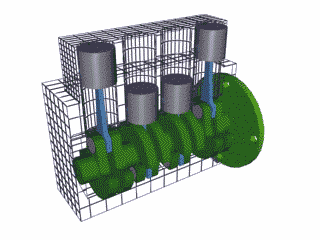Gasoline engine

A gasoline engine is a type of heat engine, specifically an internal combustion, that is powered by gasoline. These engines are the most common ways of making motor vehicles move. While turbines can be powered by gasoline, a gasoline engine refers specifically to piston-driven gasoline engines.
Gasoline engines are a lot of the reason why the world takes so much oil out of the ground to refine into petroleum products like gasoline. Worldwide, transportation is roughly 18% of our primary energy use and gasoline is a little less than half of that.[2] This means that gasoline engines use roughly 8% of the total primary energy of the world.
Anatomy of an engine
Block
The block is the backbone of the engine. It is a large block of metal, usually aluminum or steel (Formula 1 uses a magnesium alloy), with holes cut into it for the cylinders.
Cylinders
The cylinders of an engine are where the work is done. Fuel is injected into the cylinders, where it is ignited by the spark plugs, which moves the pistons, doing work.
Pistons
Pistons are devices that slide up and down inside the cylinders. Their job is to slide in and out, connected to the crankshaft, in order to turn the combusting gasoline into work.
Spark plugs
The job of a spark plug is to ignite the fuel inside the cylinder. The rapid expansion of the fuel, due to the heat created, does work on the piston, moving it away from the spark plug.
Camshaft
A camshaft is a device that manages the timing of the engine. A camshaft's job is to regulate when fuel is let into the engine, and when exhaust is let out.
Injectors
The purpose of a fuel injector is to atomize the fuel. This means to turn the liquid fuel into a mist, which drastically increases its surface area. This allows the fuel to combust more quickly, giving greater impulse to the piston.
Crankshaft
The crankshaft is the glue that connects the parts of the engine. Its purpose is to turn the linear (up and down) motion of the pistons into rotational motion. One end of the crankshaft is attached to the camshaft, via a timing belt. The other end is connected to the flywheel, which regulates the power coming out of the engine, sort of like a surge protector for your computer.
Flywheel
The flywheel is a power management device for the engine. It is connected to the clutch, which is connected to the transmission. To learn more about how an engine delivers its power to the wheels, click here.
For Further Reading
- Internal combustion engine
- Transportation energy use
- Diesel engine
- Spark plug
- Or explore a random page
References
- ↑ http://auto.howstuffworks.com/engine2.htm
- ↑ EIA 'Refining Crude Oil' online: https://www.eia.gov/energyexplained/index.cfm?page=oil_refining Accessed August 18th, 2017.

